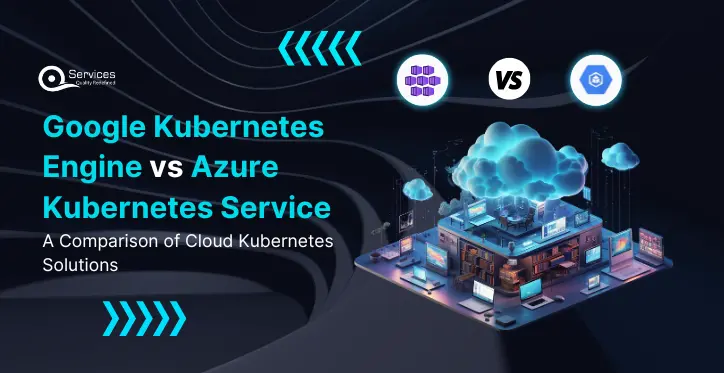
Rewards
.





CANADA
55 Village Center Place, Suite 307 Bldg 4287,
Mississauga ON L4Z 1V9, Canada
Certified Members:
.



Home » Google Kubernetes Engine vs. Azure Kubernetes Service: A Comparison of Cloud Kubernetes Solutions

With the rise of cloud-native infrastructures, Kubernetes has become the go-to platform for scaling containerized workloads. As applications evolve and grow more complex, the demand for managed Kubernetes services has never been higher. Enter Google Kubernetes Engine (GKE) and Azure Kubernetes Service (AKS) — two of the most popular platforms for running Kubernetes in the cloud.
This blog will offer a detailed comparison of GKE vs AKS, examining their features, performance, pricing, and scalability, to help you choose the best Kubernetes service for your infrastructure.
Google Kubernetes Engine as a managed Kubernetes service offered by Google Cloud, providing businesses with an efficient and reliable solution for containerized applications. Evolving from Google Container Engine (GCE), It streamlines the deploying and managing process of Kubernetes clusters across Google’s worldwide infrastructure.
It automatically adjusts the number of nodes and resources based on usage to ensure the optimal performance and cost management.
If a node fails, GKE automatically repairs or replaces it, reducing the need for manual intervention.
With GKE regions, your clusters can span across various global regions to provide high availability and faster response times for international users.
Google Compute Engine (GCE), Google Cloud Storage, and BigQuery integrate directly with GKE, making it easier to manage your infrastructure and data.
GKE’s Container Network Interface (CNI) ensures smooth communication and networking across your Kubernetes cluster, with flexible configurations for managing network traffic.
GKE Calico adds an extra layer of security, enforcing network policies to isolate and secure pod communication.
When comparing AKS vs GKE, GKE’s focus on CNI and its integration with other Google Cloud services give it an edge for businesses using Google’s cloud platform.
Azure Kubernetes Service (AKS) is Microsoft’s fully managed Kubernetes offering, designed to simplify container orchestration and accelerate cloud-native application deployment. As a core component of the Azure ecosystem, By using AKS, businesses can quickly build, scale, and manage containerized applications, optimizing their use of Kubernetes while eliminating the need for managing complex infrastructure.
AKS seamlessly integrates with services like Azure Active Directory for secure authentication and Azure DevOps for streamlined development workflows. This makes managing your entire Kubernetes ecosystem easier and faster.
With AKS, you don’t have to worry about managing master nodes—they’re fully handled by Azure at no extra cost. You can also easily scale your clusters to handle more traffic or reduce resources when they’re not needed.
AKS supports AKS GPU, which is perfect for tasks that need heavy computational power, such as machine learning or large-scale data processing.
Whether you need the advanced features of Azure CNI or the simplicity of Kuberenet, AKS lets you choose the best networking configuration for your needs.
Get free Consultation and let us know your project idea to turn into an amazing digital product.
GKE vs AKS: If you’re trying to figure out whether GKE services or AKS is the better fit for your business, you’re in the right place. We’ll compare the two on things like network security, scalability, integrations, and GPU support to make it easier to choose.
GKE services provide network security using Calico, which allows for detailed control over security policies and network encryption. AKS, on the other hand, uses Azure CNI, providing deep integration with Azure’s network infrastructure, along with Kubenet for more customizable networking in Kubernetes clusters.
GKE services seamlessly integrate with Google Cloud products like GCE, BigQuery, and Google Cloud Storage, making it ideal for businesses that rely on Google’s cloud ecosystem. AKS, in contrast, works seamlessly with Azure Active Directory and Azure DevOps, catering to businesses using Microsoft’s cloud platform.
GKE services ensure optimal performance by automatically scaling resources in response to workload demands. AKS, while offering similar auto-scaling, gives users additional flexibility by enabling scaling for both node pools and master nodes, allowing businesses to more precisely allocate resources for varying workloads.
With its powerful GPU support, GKE services enable companies to run AI, machine learning, and high-performance computing applications at scale. The cloud integration makes it simple for businesses to handle GPU-intensive workloads and scale them efficiently as needed.
Here’s how GKE and AKS compare when it comes to:
With GKE, performance stays optimal by automatically adjusting to the app’s needs, while AKS also provides strong performance, especially when used alongside Azure services.
GKE does the scaling for you, ensuring your app has what it needs without you lifting a finger. AKS gives you more control, allowing you to scale both the nodes and master nodes as needed.
GKE is available in multiple global regions, making it a great choice for businesses that need worldwide coverage. AKS is more focused on regions where Azure has data centers, so it’s ideal for Azure-centric businesses.
When choosing between Google Kubernetes pricing and AKS price, understanding how each platform charges for various components can help you decide which is the best fit for your use case.
The GKE pricing model includes costs for the control plane and the worker nodes running your applications. Pricing varies depending on the machine types you select and additional cloud services like Google Cloud Storage.
AKS offers free master node management, which is a major benefit when it comes to cost efficiency. Pricing for worker nodes is similar to GKE, based on the VM type and resources you need. Azure’s pricing model for AKS price is more flexible for scaling and offers different VM options.
When securing cloud-native environments, GKE and AKS offer different security mechanisms, but both are designed to help organizations protect their Kubernetes clusters. Here’s a breakdown of their security features:
GKE integrates with Google Cloud Identity, allowing centralized management of access control and authentication for all Kubernetes resources.
GKE allows you to configure private clusters, reducing your exposure to external threats by limiting internet access to your Kubernetes resources.
GKE uses Calico for network policies, providing the flexibility to define who can talk to whom within the cluster which isolates workloads and controls traffic flow.
AKS makes logging in secure and easy by connecting with Azure Active Directory (AAD). It’s a centralized way to manage who can access your Kubernetes clusters, ensuring that only trusted users can log in.
With RBAC, you can manage who gets to do what in your AKS environment. If you only want certain people to have access to specific resources, you can set up permissions to keep things organized and secure.
AKS uses network policies to control how different parts of your Kubernetes environment talk to each other. It helps ensure that only the right pods can connect, so your environment stays safe and secure.
With AKS GPU, security becomes critical as these instances are often used for compute-heavy tasks like AI or machine learning. Using Azure’s security features, such as Security Center, helps ensure that GPU workloads are managed safely and efficiently.
At the end of the day, GKE is the go-to for ease and speed, while AKS is the choice for flexibility and integration with Microsoft services.
GKE is ideal for organizations already using Google Cloud, offering easy integration with services like BigQuery and Cloud Storage. Its auto-scaling and global reach make it perfect for AI/ML workloads, especially for teams that need advanced GPU/TPU support.
For businesses deeply invested in Azure, AKS is the better option. Its strong integration with Azure services and robust hybrid cloud capabilities make it ideal for enterprises.
GKE’s automation and scalability allow startups to deploy and manage apps with minimal effort, so you can focus on building your product.
AKS is perfect for enterprises that need high security, regulatory compliance, and the flexibility to work across multiple clouds and on-premises systems.

When choosing between GKE and AKS, the decision often comes down to which cloud ecosystem you’re already using. GKE is perfect for organizations already on Google Cloud, offering simplicity, scalability, and strong support for AI/ML workloads.
On the other hand, AKS is ideal for Azure users, with excellent integration with Azure Active Directory and Azure DevOps, plus flexibility in networking configurations. Both platforms provide solid security, scalability, and cost management, but the best choice depends on your current cloud provider.

Pipeline failures can be expensive and harmful to the environment. Companies are using IoT applications in the oil and gas industry to prevent these breakdowns and stay ahead of problems.
![Azure IoT vs AWS IoT vs Google IoT Pricing: Feature Comparison Chart for Enterprise [2025]](https://www.qservicesit.com/wp-content/uploads/2025/03/Microsoft-Teams-vs-Slack-vs-Zoom-TCO-Analysis-for-Enterprise-Organizations-2.webp)
The Internet of Things (IoT) helps businesses run better by connecting devices, collecting information, and improving choices. But picking the best IoT cloud provider can be confusing. The main three are AWS IoT vs Azure IoT vs Google IoT.

In this blog, we’ll explore how these advances are shaping the future of field services and how companies are adapting to stay ahead in a competitive market. What are the key changes that businesses need to embrace to stay relevant and efficient?
GKE offers deeper integration with Google Cloud services and advanced features like Anthos, while AKS integrates seamlessly with Azure services and provides strong enterprise support.
Both GKE and AKS offer automatic scaling of nodes and pods, but GKE’s Autopilot mode provides more automated management of scaling and resource optimization.
Both services offer robust security features, but AKS provides enterprise-grade security with Azure Active Directory integration and advanced threat protection.
Yes, both GKE and AKS support GPU-enabled nodes for compute-intensive workloads like machine learning and data processing.
GKE integrates with Google Cloud’s Operations Suite (formerly Stackdriver), while AKS integrates with Azure Monitor and Log Analytics.
GKE, with Anthos, provides strong multi-cloud support, allowing you to manage Kubernetes clusters across different cloud providers.
GKE integrates with Google Cloud Build and other CI/CD tools, while AKS integrates with Azure DevOps and GitHub Actions for streamlined CI/CD workflows.
Both GKE and AKS are available in multiple regions worldwide, but specific regional availability can vary. Check the respective cloud provider’s documentation for the latest information.
GKE offers automated updates and maintenance with minimal downtime, while AKS provides similar capabilities with options for manual control.
GKE, with its Anthos platform, offers strong support for hybrid and multi-cloud deployments, while AKS can also be used in hybrid scenarios with Azure Arc.
Both services offer pay-as-you-go pricing models, with additional options for reserved instances and committed use discounts.
GKE uses Google Cloud’s VPC for networking, while AKS uses Azure Virtual Network. Both provide advanced networking features like network policies and private clusters.
GKE integrates with Google Cloud Storage and Persistent Disks, while AKS integrates with Azure Blob Storage and Azure Disks.
.





55 Village Center Place, Suite 307 Bldg 4287,
Mississauga ON L4Z 1V9, Canada
.




Founder and CEO

Chief Sales Officer

🎉 Thank you for your feedback! We appreciate it. 🙌